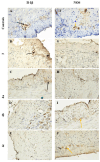2-Amino- N-Phenethylbenzamides for Irritable Bowel Syndrome Treatment
- PMID: 39064953
- PMCID: PMC11280360
- DOI: 10.3390/molecules29143375
2-Amino- N-Phenethylbenzamides for Irritable Bowel Syndrome Treatment
Abstract
Irritable bowel syndrome (IBS) is a common gastrointestinal (GI) disorder characterized by abdominal pain or discomfort. Mebeverine is an antispasmodic that has been widely used in clinical practice to relieve the symptoms of IBS. However, its systemic use usually leads to side effects. Therefore, the current paper aimed to synthesize more effective medicines for IBS treatment. We used ring opening of isatoic anhydride for the synthesis in reaction with 2-phenylethylamine. In silico simulation predicted spasmolytic activity for 2-amino-N-phenethylbenzamides. The newly synthesized compounds demonstrated a relaxation effect similar to mebeverine but did not affect the serotonin or Ca2+-dependent signaling pathway of contractile activity (CA) in contrast. Having in mind the anti-inflammatory potential of antispasmodics, the synthesized molecules were tested in vitro and ex vivo for their anti-inflammatory effects. Four of the newly synthesized compounds demonstrated very good activity by preventing albumin denaturation compared to anti-inflammatory drugs/agents well-established in medicinal practice. The newly synthesized compounds also inhibited the expression of interleukin-1β and stimulated the expression of neuronal nitric oxide synthase (nNOS), and, consequently, nitric oxide (NO) synthesis by neurons of the myenteric plexus. This characterizes the newly synthesized compounds as biologically active relaxants, offering a cleaner and more precise application in pharmacological practice, thereby enhancing their potential therapeutic value.
Keywords: anti-inflammatory activity; denaturation of albumin; mebeverine; spasmolytic activity; synthesis.
Conflict of interest statement
The authors declare no conflicts of interest.
Figures








References
-
- Lee K.J., Kim N.Y., Kwon J.K., Huh K.C., Lee O.Y., Lee J.S., Choi S.C., Sohn C.I., Myung S.J., Park H.J., et al. Efficacy of Ramosetron in the Treatment of Male Patients with Irritable Bowel Syndrome with Diarrhea: A Multicenter, Randomized Clinical Trial, Compared with Mebeverine. Neurogastroenterol. Motil. 2011;23:1098–1104. doi: 10.1111/j.1365-2982.2011.01771.x. - DOI - PubMed
MeSH terms
Substances
LinkOut - more resources
Full Text Sources
Miscellaneous

